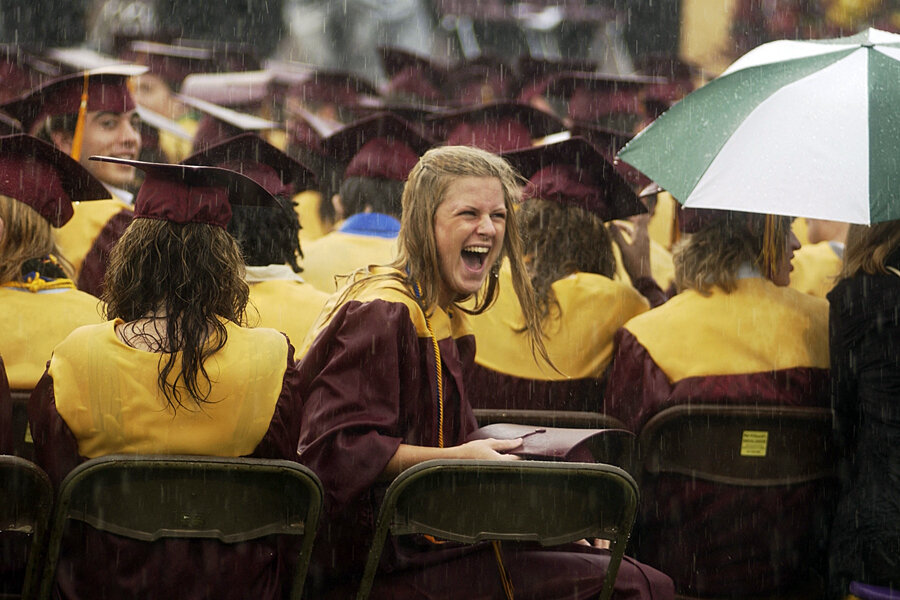Smaller share of US high school grads entering college. Why?
Loading...
| Washington
The share of young Americans who head to college has been edging down, despite the major influence that education has on individual living standards.
A new annual review finds that 65.9 percent of 2013 high school graduates were enrolled in colleges or universities as of last October. That compares with a 66.2 percent enrollment rate in 2012 and 68.3 percent in 2011.
All those numbers are below the all-time high of 70.1 percent in 2009, according to the Labor Department, which tracks the numbers and released its latest tally Tuesday.
The share of high school grads heading for advanced degrees remains high compared with enrollment rates in many prior decades. To some degree, an improving job market may be one reason for the decline since 2009, as some young people opt for employment rather than more school.
But today’s enrollment rates are little changed from the late 1990s, despite efforts by President Obama and others to ramp up educational opportunities as a path to economic success – and despite polls showing that Americans view higher education as financially worthwhile. Meanwhile, nations that compete with the US for high-skill jobs have been boosting their rates of higher-education participation.
Economist Heidi Shierholz calls the US trend worrisome, particularly to the extent that a still-weak job market is making it hard for students to put themselves through school or for their parents to help them.
“Falling college enrollment indicates that upward mobility may become more difficult for working class and disadvantaged high school graduates,” Ms. Shierholz, of the Economic Policy Institute, writes in an analysis of the new numbers.
Falling enrollment, coming when employment is not rising very strongly, means that a larger share of young people are “disconnected,” neither enrolled nor employed, she says. That could hold back their long-term career opportunities – and their potential contributions to America’s economic growth.
The enrollment decline coincides with public concerns about the pace of college tuition hikes, the burden posed by that student debt, and related soul-searching about whether college has lost some of its value in a weak job market.
Even as these issues become the topics of cover stories and books, Americans continue to view higher education as a crucial ladder upward.
Nearly 3 in 4 Americans in a recent Gallup poll agreed that having a certification or degree beyond high school is essential for getting a good job. Only 11 percent disagreed.
Employment data from the Labor Department confirm the notion that education and employability are linked. As of March, the unemployment rate is 3.4 percent for workers with a bachelor’s degree or higher, 6.3 percent for workers with high-school diplomas, and 9.6 percent for people who never finished high school.
Those numbers are for people of all ages, but the pattern also holds for young people, the new report finds. As of October, the jobless rates for young men and women with at least a bachelor's degree were 7.9 percent and 6.5 percent, respectively, well below the unemployment level for peers with less education.
College grads may also have an easier time when it comes to simply finding “help wanted” signs. A report released Wednesday by Georgetown University’s Center on Education and the Workforce finds that 80 to 90 percent of job openings for workers with a bachelor’s degree or better are posted online. In comparison, online listings are posted for less than half the job openings for workers with less education.
In a job-skills speech earlier this month, Mr. Obama emphasized that higher learning doesn’t have to mean a bachelor’s degree.
“Not all of today’s good jobs require a four-year college degree, but I promise you, there’s not a job out there that’s going to pay a lot if you don’t have some sort of specialized training,” Obama said at a Pennsylvania community college. “Our best bet is keeping ahead in the skills race.”
The US is by some measures one of the most highly educated nations in the world. But other nations have passed America, when rated by the share of young people who are now getting two- or four-year college degrees. South Korea, Japan, Canada, and Britain are among the nations ahead by this measure.








